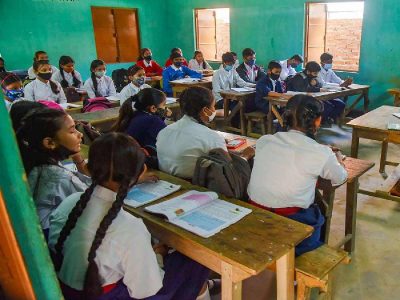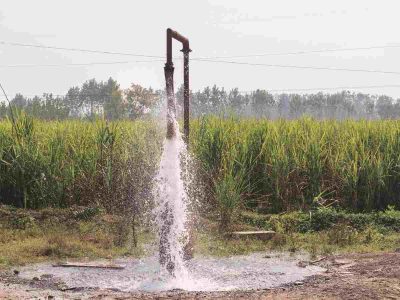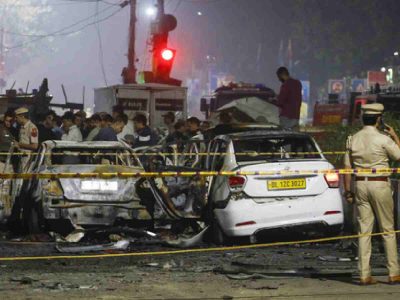Kirari: Seventh-grader Mohammed Rizwan Khan wakes up each day, preparing for school. He brushes his teeth, showers, packs his bag, and holds out hope that today might be the day he can finally return. But for the past week, nothing has changed.
The Government Boys Senior Secondary School in Kirari Suleman Nagar in north-west Delhi has been closed due to severe waterlogging that has transformed the premises into a pool of a mix of sewage and rainwater.
“I haven’t been able to attend school for almost a week. Every inch of the campus is submerged, and it’s impossible to even enter because of the flooding,” shared Khan.
“There’s no way for the premises to dry out either. Even the roads have turned into rivers, making it impossible for us to walk to school,” added Khan.
Presently, the boys’ school remains closed, with no one able to go in or out, although a few workers try to maintain the premises in a bid to alleviate the situation. Unfortunately, the effort is to no avail.
Also read: Delhi government yet to learn from the coaching centre incident that left 3 dead
In the absence of in-person classes, online lessons have never been a viable alternative. “The Google Meet link does not work half of the time because our schools are not well-equipped enough to handle such situations,” said a worried Khan, whose mid term exams were scheduled to begin on September 25 but now face uncertainty as the school remains inaccessible.
A faling stormwater system
According to school officials, the situation has worsened since the pandemic in 2020, when maintenance was neglected. A nearby pond, skirting the school’s boundary, has allowed its water to seep into the premises.
An ”artificial” pond, created by incessant dumping, has further compounded the issue, blocking any natural flow of water at the edges.
“The school is built on low-lying land, so whenever it rains, the water floods inside. It’s become a regular occurrence,” explained an official. Even in dry spells, residents are forced to use these so called ponds for drainage, as the local sewers overflow due to a lack of a proper drainage system.
It’s not just the boys’ school grappling with the issue— the adjacent Sarvodaya Boys and Girls School is also affected, though not as severely. While the initial sight upon entering may not seem as daunting, a deeper look inside reveals the true extent of the problem.
The school, devoid of any children, greets visitors with a make shift bridge of benches. People carefully shuffle across these benches, taking measured steps to avoid falling into waist-deep water. With no handrails or support on either side, a single misstep could send them tumbling into the flood waters.
The 14-year-old Khan’s water woes extend beyond his school— his entire neighbourhood is also submerged. Beyond the school being inaccessible, children are also trapped indoors, unable to go outside to play, as the village itself remains flooded and cut off from the outside world.
In Nithari village, part of Kirari Suleman Nagar’s Vidhan Sabha constituency, knee-deep water logged alleys are a common sight. The village’s health and education systems, along with basic civic infrastructure, have long been neglected.
A hub for diseases and snakes
According to Khan’s mother, Zeenat Khatoon, the school has been struggling with waterlogging since the rains began. “It’s been about a month since the rains started, flooding the school every day. My children come home and tell me that someone has fallen sick because of the waterlogging,” said an anxious Khatoon.
The situation is exacerbated by the area’s low-lying landscape, where rain transforms roads into pools and farmland into lakes. “People used to cultivate wheat here,” a resident explained, gesturing to a waterlogged patch with a lone tree jutting from its surface.
“But since the pandemic, this area has become a lake every monsoon, with everyone littering and draining the water into this land.”
The region is home to several Delhi Development Authority (DDA) plots, which have now become breeding grounds for mosquitoes. Additionally, the monsoon has brought an influx of snakes, which are now appearing in homes and even on school grounds. Khatoon recalls a frightening encounter: “A snake crawled up to my feet, and we had to stop it and beat it to death.”
For residents of the village, a walk to the market, which once took five minutes, has turned into a 30-minute detour, trying to avoid snake-ridden pathways just to buy fresh vegetables.
Also read: ‘Attendance norms arbitrary’, ‘way for colleges to earn money’, say students
A delayed drainage project
In 2021, the Arvind Kejriwal-led government announced plans for a 4.5-kilometre drain to address the failing sewage system in the Kirari constituency.
Four years later, however, there’s little evidence of progress. According to Rituraj Govind, the Aam Aadmi Party (AAP) MLA from Kirari, the COVID pandemic significantly delayed construction.
“It was due to the pandemic that we missed the deadline. We began planning and initiating work on the drainage system in 2020, but then the pandemic struck. We have completed 17 per cent of the work, and once the drain is constructed, the public will no longer face these issues,” Govind explained.
He acknowledged that the problems have worsened this year due to incessant rainfall. “Whenever it rains, all work gets stalled. We can not improve the drainage system or address the waterlogging issues at this stage. I hope the situation will improve now that the rains have stopped,” he said.





